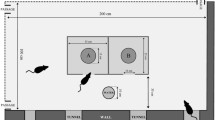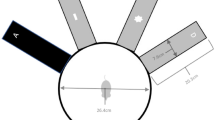Abstract
Predator odors induce defensive behavior in many prey species. For various reasons, studies carried out up to now have been unable to establish whether predator odor recognition is innate or not. Mostly, only particular odors or wild-living (i.e., experienced) test animals have been used in these studies, restricting the conclusiveness of the observations. In the present study, the behavioral effects of exposure to different predator odors on predator odor-naive laboratory male rats were compared with the effects of different nonpredator odors and of a no-odor control stimulus. Results show that exposure to urine of canids and felids, but not of herbivores or conspecifics, induce defensive behaviors. Taken together, the study provides support for the hypothesis that there is an innate recognition of predator odors in laboratory rats.


Similar content being viewed by others
References
Amo, L., López, P. and Martín, J. 2004. Trade-offs in the choice of refuges by common wall lizards: Do thermal costs affect preferences for predator-free refuges? Can. J. Zool. 82:897–901.
Apfelbach, R., Blanchard, C. D., Blanchard, R. J., Hayes, R. A. and Mcgregor, I. S. 2005. The effects of predator odors in mammalian prey species: A review of field and laboratory studies. Neurosci. Biobehav. Rev. 29:1123–1144.
Berton, F., Vogel, E. and Belzung, C. 1998. Modulation of mice anxiety in response to cat odor as a consequence of predators diet. Physiol. Behav. 65:247–254.
Blanchard, R. J. and Blanchard, D. C. 1971. Defensive reactions in the albino rat. Learn. Motiv. 2:351–362.
Blanchard, R. J. and Blanchard, D. C. 1990. Anti-predator defense as models of animal fear and anxiety, pp. 89–108, in P. F. Brain, S. Parmigiani, and R. J. Blanchard (eds.). Fear and Defence. Church and Harwood Academic, New York.
Blanchard, R. J., Blanchard, D. C., Rodgers, J., and Weiss, S. M. 1990a. The characterization and modeling of antipredator defensive behavior. Neurosci. Biobehav. Rev. 14:463–472.
Blanchard, R. J., Blanchard, D. C., Weiss, S. M., and Meyer, S. 1990b. The effects of ethanol and diazepam on reactions to predatory odors. Pharmacol. Biochem. Behav. 35:775–780.
Blanchard, D. C., Griebel, G., and Blanchard, R. J. 2003a. The Mouse Defense Test Battery: Pharmacological and behavioral assays for anxiety and panic. Eur. J. Pharmacol. 463:97–116.
Blanchard, D. C., Markham, C., Yang, M., Hubbard, D., Madarang, E., and Blanchard, R. J. 2003b. Failure to produce conditioning with low-dose trimethylthiazoline or cat feces as unconditioned stimuli. Behav. Neurosci. 117:360–368.
Burwash, M. D., Tobin, M. E., Woolhouse, A. D., and Sullivan, T. P. 1998. Laboratory evaluation of predator odors for eliciting an avoidance response in roof rats (Rattus rattus). J. Chem. Ecol. 24:49–65.
Campbell, T., Lin, S., Devries, C., and Lambert, K. 2003. Coping strategies in male and female rats exposed to multiple stressors. Physiol. Behav. 78:495–504.
Carobrez, A. P., Teixeira, K. V., and Graeff, F. G. 2001. Modulation of defensive behavior by periaqueductal gray NMDA/glycine-B receptor. Neurosci. Biobehav. Rev. 25:697–709.
Dickman, C. R. 1992. Predation and habitat shift in the house mouse, Mus domesticus. Ecology 73:313–322.
Dickman, C. R. and Doncaster, C. P. 1984. Responses of small mammals to red fox (Vulpes vulpes) odour. J. Zool. 204:521–531.
Dielenberg, R. A. and McGregor, I. S. 2001. Defensive behavior in rats towards predatory odors: A review. Neurosci. Biobehav. Rev. 25:597–609.
Edut, S. and Eilam, D. 2003. Rodents in open space adjust their behavioral response to the different risk levels during barn-owl attack. BMC Ecol. 3:10–22.
Eilam, D., Dayan, T., Ben-Eliyahu, S., Schulman, I. I., Shefer, G., and Hendrie, C. A. 1999. Differential behavioural and hormonal responses of voles and spiny mice to owl calls. Anim. Behav. 58:1085–1093.
Epple, G., Mason, J. R., Nolte, D. L., and Campbell, D. L. 1993. Effects of predator odors on feeding in the mountain beaver (Aplodontia rufa). J. Mammol. 74:715–722.
Farmer-Dougan, V., Chandrashekar, S., Stutzman, D., Bradham, K., and Dougan, J. D. 2005. Fox urine as an aversive stimulus: Modification of a passive avoidance task. J. Gen. Psychol. 132:313–320.
Fendt, M. and Fanselow, M. S. 1999. The neuroanatomical and neurochemical basis of conditioned fear. Neurosci. Biobehav. Rev. 23:743–760.
Fendt, M., Endres, T., Lowry, C. A., Apfelbach, R., and McGregor, I. S. 2005. TMT-induced autonomic and behavioral changes and the neural basis of its processing. Neurosci. Biobehav. Rev. 29:1145–1156.
Gese, E. M. and Ruff, R. L. 1997. Scent-marking by coyotes, Canis latrans: The influence of social and ecological factors. Anim Behav. 54:1155–1166.
Glowacinski, Z. and Profus, P. 1997. Potential impact of wolves Canis lupus on prey populations in eastern Poland. Biol. Cons. 80:99–106.
Goldyn, B., Hromada, M., Surmacki, A., and Tryjanowski, P. 2003. Habitat use and diet of the red fox Vulpes vulpes in an agricultural landscape in Poland. Z. Jagdwiss. 49:191–200.
Hendrie, C. A. 1991. The calls of murine predators activate endogenous analgesia mechanisms in laboratory mice. Physiol. Behav. 49:569–573.
Hendrie, C. A., Weiss, C., and Eilam, D. 1996. Exploration and predation models of anxiety: Evidence from laboratory and wild species. Pharmacol. Biochem. Behav. 54:13–20.
Hirsch, S. M. and Bolles, R. C. 1980. On the ability of prey to recognize predators. Z. Tierpsychol. 54:71–84.
Kats, L. B. and Dill, L. M. 1998. The scent of death: Chemosensory assessment of predation risk by prey animals. Ecoscience 5:361–394.
Labra, A. and Niemeyer, H. M. 2004. Variability in the assessment of snake predation risk by Liolaemus lizards. Ethology 110:649–662.
Markham, C. M., Blanchard, D. C., Canteras, N. S., Cuyno, C. D., and Blanchard, R. J. 2004. Modulation of predatory odor processing following lesions to the dorsal premammillary nucleus. Neurosci. Lett. 372:22–26.
McGregor, I. S., Schrama, L., Ambernoon, P., and Dielenberg, R. A. 2002. Not all ‘predator odours’ are equal: Cat odour but not 2,4,5 trimethylthiazoline (TMT; fox odour) elicits specific defensive behaviours in rats. Behav. Brain Res. 129:1–16.
McNaughton, N. and Corr, P. J. 2004. A two-dimensional neuropsychology of defense: Fear/anxiety and defensive distance. Neurosci. Biobehav. Rev. 28:285–305.
Misslin, R. 2003. The defense system of fear: Behavior and neurocircuitry. Neurophysiol. Clin. 33:55–66.
Nolte, D. L., Mason, J. R., Epple, G., Aronov, E., and Campbell, D. L. 1994. Why are predator urines aversive to prey? J. Chem. Ecol. 20:1505–1516.
Rosell, F. 2001. Effectiveness of predator odors as grey squirrel repellents. Can. J. Zool. 79:1719–1723.
Stapley, J. 2003. Differential avoidance of snake odours by a lizard: Evidence for prioritized avoidance based on risk. Ethology 109:785–796.
Sullivan, T. P., Nordstrom, L., and Sullivan, D. S. 1985a. Use of predator odors as repellents to reduce feeding damage by herbivores. I. Showshoe hares (Lepus americanus). J. Chem. Ecol. 11:903–911.
Sullivan, T. P., Nordstrom, L., and Sullivan, D. S. 1985b. Use of predator odors as repellents to reduce feeding damage by herbivores. II. Black-tailed deer (Odocoileus hemionus columbianus). J. Chem. Ecol. 11:921–935.
Sullivan, T. P., Crump, D., and Sullivan, D. S. 1988. Use of predator odors as repellents to reduce feeding damage by herbivores. III. Montane and meadow voles (Microtus montanus and Microtus pennsylvannicus). J. Chem. Ecol. 14:363–378.
Sullivan, G. M., Apergis, J., Bush, D. E., Johnson, L. R., Hou, M., and Ledoux, J. E. 2004. Lesions in the bed nucleus of the stria terminalis disrupt corticosterone and freezing responses elicited by a contextual but not by a specific cue-conditioned fear stimulus. Neuroscience 128:7–14.
Swihart, R. K., Pignatello, J. J., and Mattina, M. J. I. 1999. Adverse responses of white-tailed deer, Odocoileus virginianus, to predator urines. J. Chem. Ecol. 17:767–777.
Takahashi, L. K., Nakashima, B. R., Hong, H., and Watanabe, K. 2005. The smell of danger: A behavioral and neural analysis of predator odor-induced fear. Neurosci. Biobehav. Rev. 29:1157–1167.
Wiltgen, B. J. and Fanselow, M. S. 2003. A model of hippocampal–cortical–amygdala interactions based on contextual fear conditioning, pp. 83–103, in K. J. Jeffries (ed.) The Neurobiology of Spatial Behavior. Oxford University Press, Oxford.
Yamada, K. and Nabeshima, T. 1995. Stress-induced behavioral responses and multiple opioid systems in the brain. Behav. Brain Res. 67:133–145.
Zar, J. H. 1999. Biostatistical Analysis. Prentice-Hall, Upper Saddle River, NJ.
Acknowledgments
The author thanks Daniel Endler, Daniela Schmieder, and Verena Koller for assistance with these experiments, as well as Dr. Björn Siemers for comments on the manuscript.
Author information
Authors and Affiliations
Corresponding author
Rights and permissions
About this article
Cite this article
Fendt, M. Exposure to Urine of Canids and Felids, but not of Herbivores, Induces Defensive Behavior in Laboratory Rats. J Chem Ecol 32, 2617–2627 (2006). https://doi.org/10.1007/s10886-006-9186-9
Published:
Issue Date:
DOI: https://doi.org/10.1007/s10886-006-9186-9




